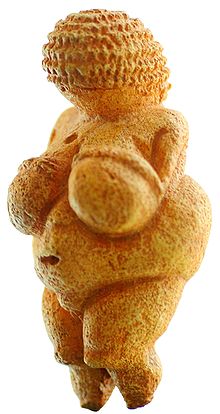Venus figurine
Possibly among the earliest traces of art are Venus figurines. These are figurines that show women. Most often the women are shown as being pregnant, with breasts well visible. The figurines occur from Western Europeto Siberia. Most are about 30.000 years old; Two figurimes have been found that are much older, the Venus of Tan-Tan has been dated to 500.000 to 300.000 years ago. It was found in Morocco. The Venus of Berekhat Ram was found on the Golan Heights. It has been dated to 300.000 to 200.000 years ago. It may be the earliest thing that shows the human form.

Different kind of stone, bones and ivory were used to make the figurines. Some are also made of clay which was then burned in a fire. This is one of the earliest known traces of the use of ceramics.
Today it is not known what the figurines meant for the people who made them. There are two basic interpretations:
- They may be representations of human fertility, or they may have been made to increase it.
- They may represent (fertility) goddesses.
Scientists have excluded that they were linked to the fertility of fields, because agriculture had not yet been discovered.

The two figurines that are older may have mostly formed by natural processes. The Venus of Tan-Tan was covered with a substance that could have been some kind of paint.[1] It contained traces of Iron and Manganese.[1] The figurine of Berekhat Ram shows traces that someone worked on it with a tool. A study done in 1997 states that this could not have been done by nature alone[2]
References
change- ↑ 1.0 1.1 "'Oldest sculpture' found in Morocco". BBC News online. 23 May 2003.
- ↑ Alexander Marshack (1997). "The Berekhat Ram figurine: a late Acheulian carving from the Middle East" (PDF). Archived from the original (pdf) on 2008-07-26. Retrieved 2008-05-16.